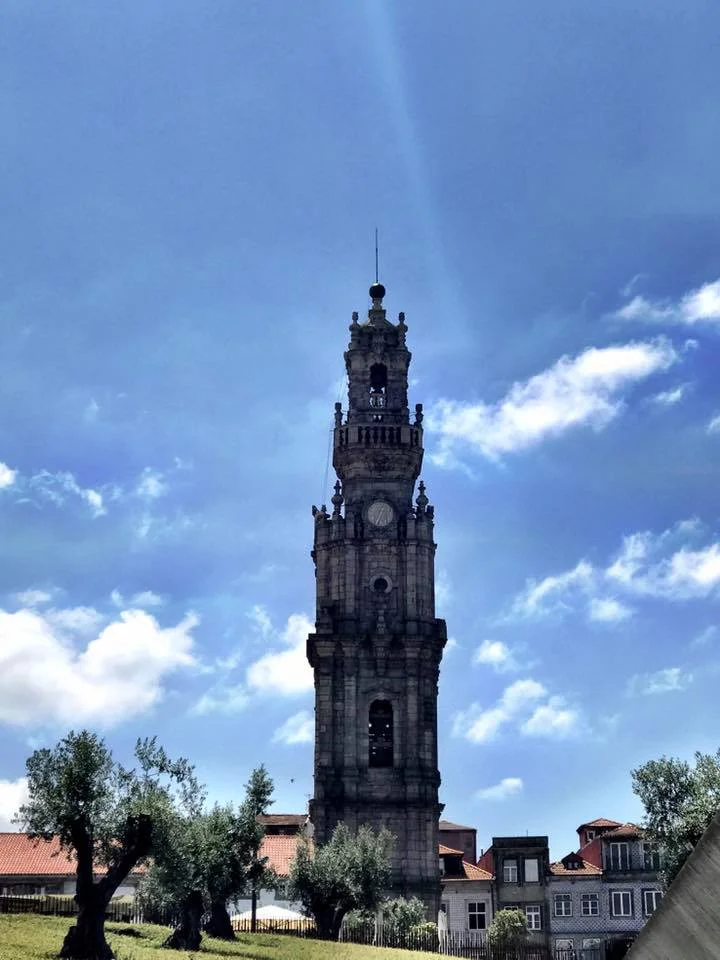Porto's iconic everything
Porto is a great walking city with much to explore and a long history that is fun to learn about. I opted for a free 3 hour walking tour and ended up having the guide all to ourselves. Here are some of the highlights.
Torre dos Clérigos (Clérigos Tower), is a iconic landmark, attached to The Church of Clérigos, a genuine baroque masterpiece dating from the mid-18th century. It was designed by Nicolau Nasoni, an architect of Italian origin who contributed to many monuments around the city and the north of Portugal. Nasoni, on his request, was buried here in a small chapel .
In 1917, the Tower of Clérigos was successfully climbed by two Spanish acrobats, the Puertullanos, a father and son team, in front of an enormous crowd. This is a feat that, on looking up at the Tower, would seem impossible.
Portugal is well known for it’s beautiful azulejo tiles dating as far back as the 13th century, when the Moors invaded the land that now belongs to Spain and Portugal, but they secured their foothold in Portuguese culture between the 16th and 17th centuries. Antique azulejos were decorated in a simple color palate, dominated by blues and whites. It is believed that these colors were influenced by the Age of Discoveries (15th – 18th centuries) and considered fashionable at the time. The other colors that appeared were yellow (sometimes looking gold) and green. During the last couple of centuries, the use of azulejos exploded. Today, it is common to see them decorating churches, monasteries, restaurants, bars, railway and subway stations, palaces, and regular homes. They are also used extensively in interior decoration.
São Bento Railway Station holds within 20,000 magnificent azulejo tin-glazed ceramic tiles depicting Portugal’s past - its royalty, its wars, and its transportation history. The blue and white tiles were placed over a period of 11 years (1905–1916) by artist Jorge Colaço.
Carmo and Carmelitas Churches are beautiful to behold and I love the azulejo tiles. What is not readily noticable is these are 2 churches, Igreja dos Carmelitas Descalços was built in the 17th century for Carmelite nuns, and Igreja do Carmo was built in the 18th century for Carmelite monks. Even less noticable is the tiny house that separates them, which is only 3 feet wide. Urban legend says says it’s because the archbishops couldn’t get along, so one built a church next door to the other in the ultimate architectural spite move. Local guides give two different reasons for the skinny house’s existence. Some chalk it up to an old law stipulating that two churches couldn’t share a wall. Others say the strange home was erected to keep the nuns and monks from getting too cozy with one another.
We didn't just get a history lesson on the walking tour, we learned about some urban myths as well. It turns out JK Rowling lived in Porto in 1991 for 2 years teaching English and it is here she says she wrote her favorite chapter in The Philosophers Stone. It is said that Lello bookshop was an inspiration for Flourish and Blotts and the Grand Hogwarts Stairway. Additionally the University students have a uniform that I recognized immediately when I saw a young girl go by...she looked just like Hermione.
The Lello Bookstore was built in 1906 in Porto, Portugal by The Lello Brothers (Antonio and Jose) who formerly owned another bookstore a few streets away. Their new bookstore is one of the most ornate bookstores in the world, mixing Neo-Gothic and Art Dec elements.
A favorite pastime is exploring the Ribeira, a small neighbourhood by the Douro river, part of Unesco’s World Heritage. It is one of the city's oldest neighbourhoods and certainly one of its highlights. The waterfront (Cais da Ribeira) is long strip of cafes, restaurants and shops overlooking the river and the Port houses of Vila Nova de Gaia on the opposite bank. Dominating the Cais da Ribeira is Porto's iconic Ponte Dom Luis I bridge which spans the Douro to Vila Nova de Gaia. Completed in 1886 the bridge was designed by a student of Gustave Eiffel and with its iron framework it this is not difficult to guess.
Before the construction of the Dom Luis I bridge residents used to cross the river using a makeshift pontoon bridge made from around 20 old port boats lashed together by steel cables. The 'Ponte das Barcas' (Bridge of Boats) as it was known was built in 1806 and you can in fact still see the old pillars right next to the Dom Luis I bridge. Back in those days the crossing was made all the more precarious by the fact that the river was somewhat wilder as there were no dams upstream to calm the flow. Disaster struck in 1809 when, during the Peninsula Wars, Napoleon invaded the city. The population flees, desperate, towards the Douro river. The boats’ bridge was not enough to sustain the despair of thousands of fugitives, having succumbed to its weight. The number of deaths of this terrible day is estimated at 4,000.
The city still recalls the disaster of the boats’ bridge in the Alminhas das Pontes, where candles have perpetually burned for the past 200 years for the soul of those who found their death in the water.
Famous Francesinhas sandwiches made veggie; local white Port wine when I asked for the least sweet, and my last glass of red in our neighborhood cafe and tomorrow I train to Lisbon.

























